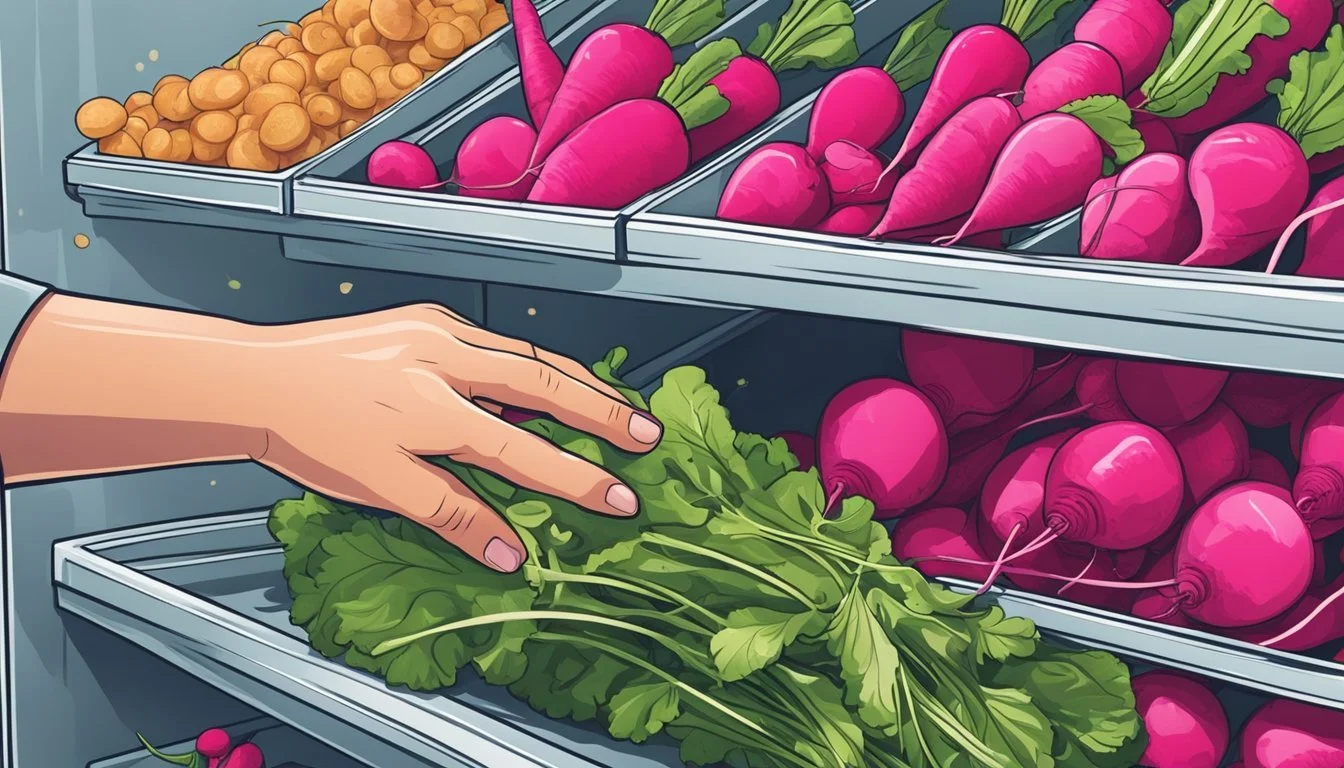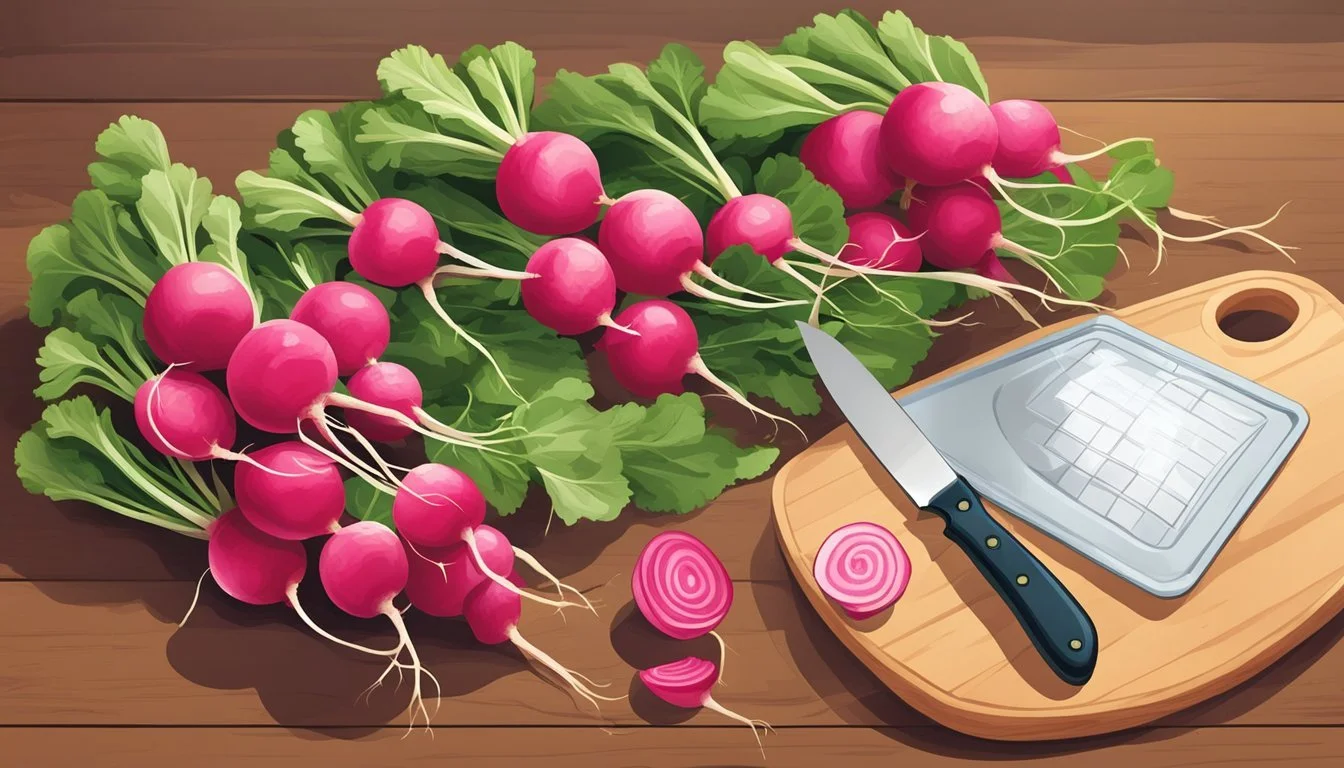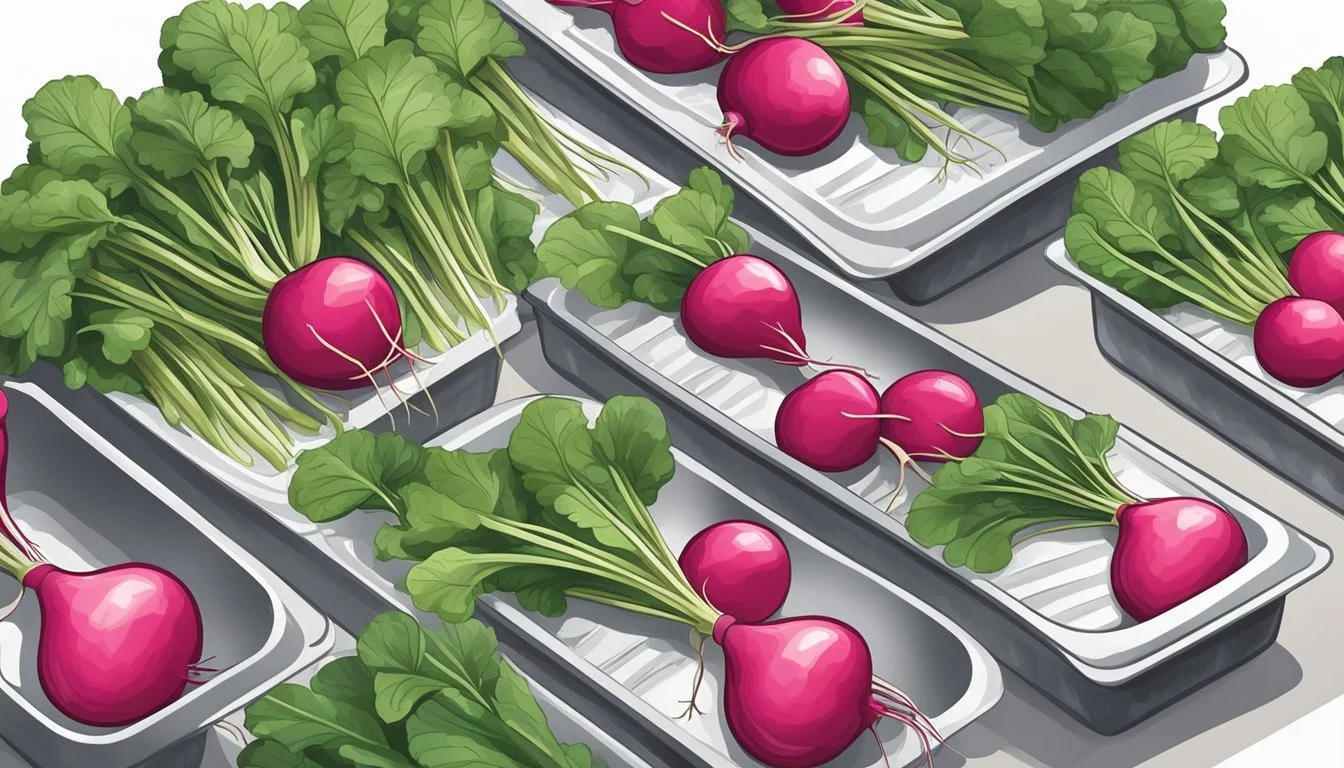How to Freeze Fresh Radishes for Crunchy Snacks
A Step-by-Step Guide
Radishes are a vibrant and peppery root vegetable often relished for their satisfying crunch and flavor, frequently serving as a bright addition to salads and dishes. Preserving their characteristic bite and zest can be challenging, especially when attempting to maintain freshness over time. Freezing presents a practical solution to extend the life of radishes while preserving their nutritional value. The process is straightforward, ensuring radishes are ready for use at a later date without the significant loss of their natural texture and taste.
To successfully freeze radishes, one must understand that while freezing will slightly alter the radish's crispness, proper techniques can minimize texture changes and maintain quality. It is essential to begin with fresh, firm radishes, as they are more likely to retain their desirable qualities post-freezing. Preparing radishes for freezing involves cleaning them meticulously, removing their tops, and blanching—this brief exposure to boiling water followed by immersion in an ice bath helps to preserve color, flavor, and to some extent, the crunchy texture.
The final step is to dry the radishes thoroughly to prevent ice crystals from forming during freezing, which can turn them mushy. Once dry, radishes can be packed in moisture-resistant containers or airtight freezer bags for storage. This method keeps radishes suitable for later use in cooked dishes, where they can impart their inherently sharp flavor and provide a somewhat crisp texture, reminding of fresh radishes.
Selecting Radishes for Freezing
Before freezing radishes, it's essential to choose the best quality produce. Freshness and cleanliness will ensure the radishes maintain their crunchy texture and vibrant color even after being frozen.
Importance of Radish Quality
Selecting high-quality radishes is crucial for successful freezing. Radishes of superior quality will freeze better, retaining their crispness and flavor. To guarantee optimal results:
Skin: Look for radishes with firm, unblemished skin. Soft spots or wrinkles may indicate old or poor-quality produce.
Color: Ideally, radishes should have a bright, consistent color. Dull or uneven coloring can suggest they are past their prime.
Identifying Freshness
Radishes should be assessed for freshness to ensure they are ideal for freezing:
Cleanliness: Radishes must be free of dirt to avoid contamination. A gentle cleaning under cold water is recommended before further processing.
Feel: They should feel firm to the touch. Any softness can affect the texture unfavorably when thawed.
Green Tops: If still attached, the green tops should be vibrant and perky, not wilted or yellowing, as this reflects overall freshness.
Preparing Radishes for Freezing
Freezing preserves the crispness and flavor of radishes for later use. The preparation process is critical and involves thorough cleaning and meticulous slicing before the actual freezing.
Cleaning and Trimming
Before freezing radishes, one must ensure they are clean and trimmed. Here's how to prepare them:
Wash the radishes under cold running water to remove any dirt or debris.
Use a brush to gently scrub the surface if they're particularly dirty.
Trim the tops and roots, and discard any damaged or bruised radishes.
Slicing and Dicing Options
After cleaning, decide on the preferred size and shape for freezing:
Whole: Small radishes can be frozen whole and are especially good for later roasting or pickling.
Slices: Cut radishes into uniform slices for quick defrosting and use in salads for added crunch.
Diced: Diced radishes are perfect for stews or soups where they can add a peppery flavor.
Slice or dice with a sharp knife for consistency in thickness, which ensures even freezing and defrosting.
Blanching Radishes before Freezing
Blanching radishes effectively prepares them for freezing by preserving their texture and flavor. This two-step process involves boiling followed by rapid cooling.
Blanching Process
To blanch radishes, one must first wash and trim the required amount. Slicing is optional but can ensure even blanching. Next, one must bring a pot of water to a full boil. It is important to ensure there is enough water to cover all the radishes. Once the water is boiling, the radishes are placed in the pot for 2-3 minutes. The timing is crucial as it's just long enough to deactivate enzymes that cause spoilage but not so long as to cook the radishes fully.
Cooling and Draining
Immediately following the blanching, the radishes should be transferred to an ice water bath. This abrupt temperature change stops the cooking process. They should stay submerged in the ice bath for the same amount of time they were boiled, typically 2-3 minutes. After cooling, the radishes need to be dried thoroughly. They can be laid out on a clean cloth or paper towel and patted gently to remove excess moisture. This helps prevent ice crystals from forming during freezing, which could damage their texture.
Packing and Freezing Radishes
Before placing radishes in the freezer, they must be properly packed to maintain freshness and prevent freezer burn. Utilizing airtight containers or freezer bags ensures that radishes retain their crisp texture for convenient snacks (What wine goes well with snacks?).
Suitable Containers and Bags
Airtight Containers: Airtight containers are ideal for freezing radishes as they prevent air from entering and causing freezer burn. Containers should be made of freezer-safe material.
Selection: Choose containers that can be sealed tightly.
Stacking: Opt for containers that are stackable to maximize freezer space.
Freezer Bags: Freezer bags are an alternative to containers and can be more space-efficient.
Removing Air: Press out as much air as possible before sealing.
Flattening: Spread the radishes in a single layer within the bag. This allows for even freezing and easy stacking.
Labeling and Dating
Labels: Proper labeling is crucial to identify contents and avoid any guesswork.
Information: Include the name 'Radishes' and the date of freezing.
Visibility: Use a permanent marker for clear, long-lasting labels.
Dating: Dating ensures proper rotation and usage within the optimal time frame.
Format: Use a consistent date format, such as "MM/DD/YYYY."
Placement: Place labels on a visible spot on containers or bags.
After labeling, the radishes can be carefully placed in the freezer, ensuring they remain at a stable temperature for optimal preservation.
Thawing and Using Frozen Radishes
When using frozen radishes, proper thawing is essential to maintain texture and taste. One can use these radishes in a variety of recipes to add a crisp, subtle bite to their dishes.
Thawing Techniques
Thawing frozen radishes should be done with care to preserve their firmness. Place them in the refrigerator for several hours or overnight, allowing them to thaw slowly and retain their structure. It's important not to rush the thawing process by using heat, as radishes can become soggy. For a quick thaw, one might place them under cold running water, but this method may slightly reduce their crunchiness.
Incorporating into Recipes
Once thawed, radishes can be added directly to salads or slaws for a fresh, zesty flavor. Cooking with radishes is also possible; they can be sautéed lightly to be included in stir-fries or mixed with other roasted vegetables. While the texture might change slightly due to the freezing process, they still impart a peppery kick to any cooked dish. For best results, one should add thawed radishes toward the end of the cooking process to retain some of their crisp texture.
Tips for Maintaining Freezing Quality
When freezing radishes, the preservation of their texture and quality is paramount. They should retain their crunchiness to ensure they serve as delightful snacks once defrosted.
Preventing Freezer Burn
Seal Properly: To ward off freezer burn, ensure radishes are placed in airtight containers or heavy-duty freezer bags. Expelling as much air as possible before sealing prevents ice crystals from forming.
Blanching: Briefly boiling radishes before freezing slows down enzyme action that can diminish flavor and texture. This step should be followed by immediate cooling in ice water to stop the cooking process.
Optimizing Freezer Settings
Consistent Temperature: Keep the freezer at 0°F (-18°C) consistently. Fluctuating temperatures can increase the risk of freezer burn and lead to a mushy texture upon thawing.
Freezer Placement: Store radishes in the center of the freezer where temperature variation is minimal. Avoid the door area where temperature fluctuates with frequent opening.
By following these specific steps, one maximizes the potential for radishes to maintain their quality and texture, ensuring a crunchy snack once thawed.
Alternative Radish Preservation Methods
Aside from freezing, one can preserve radishes by pickling or dehydrating them. These methods offer flavorful and texturally diverse ways to enjoy radishes.
Pickling Radishes
To preserve radishes through pickling, one needs to create a vinegar-based pickling solution. A standard solution involves vinegar, water, salt, and sugar, heated until the solids dissolve. Radishes are usually sliced thinly to allow the pickling solution to penetrate easily.
Ingredients:
Radishes, thinly sliced
1 cup white vinegar
1 cup water
1 tablespoon salt
2 tablespoons sugar
Instructions:
Place the sliced radishes in a clean jar.
Combine vinegar, water, salt, and sugar in a saucepan.
Bring the mixture to a boil, stirring until sugar and salt dissolve.
Pour the hot liquid over radishes and seal the jar.
The radishes should be left to pickle for at least one week before consuming, allowing the flavors to develop. Pickled radishes can be stored in the refrigerator for several months.
Dehydrating Radishes
Dehydrating radishes preserves them by removing moisture, which inhibits the growth of microorganisms that cause spoilage. Dried radishes can make for a crunchy snack or a flavorful addition to various dishes.
Process:
Wash and trim the radishes.
Slice them thinly.
Arrange the slices on a dehydrator tray.
For dehydrating, the radishes are placed in a dehydrator at 125-135°F (52-57°C) until they are crisp, which can take 6-10 hours depending on the thickness of the slices. One should ensure that the radishes are completely dry to avoid mold growth during storage. The dried radishes can be stored in an airtight container in a cool, dark place for several months.
Health Benefits and Nutritional Information
Radishes are a low-calorie vegetable that packs a nutritional punch. They are a good source of water content, ensuring hydration, and they contain dietary fiber which aids in digestion and contributes to a feeling of fullness. A typical serving of radishes provides vital nutrients without many calories.
Nutritional Content per 1 Cup (116g) of Sliced, Raw Radishes:
Calories: 19
Fat: 0.1g
Sodium: 45mg
Carbohydrates: 4g
Fiber: 2g
Sugar: 2.2g
Vitamins and minerals are abundant in radishes. They are an excellent source of vitamin C, a nutrient important for immune function and skin health. Folic acid, also found in radishes, supports cell growth and function, and is especially important for pregnant women in aiding fetal development.
Nutrient Importance Vitamin C Supports the immune system and skin health Folic Acid Aids in cell growth and development Potassium Regulates fluid balance, nerve signals Calcium Essential for bone health and muscle function
Radishes also contain potassium, which is essential for maintaining proper fluid balance in the body and facilitating nerve transmission and muscle function. Though less notable as a source of calcium, radishes contribute to an overall dietary intake that supports bone strength and function.
In summary, radishes are not only a crunchy, refreshing snack but also a healthy addition to the diet, delivering essential nutrients including fiber, vitamin C, potassium, and folic acid among others.
Frequently Asked Questions
In this section, we address common questions regarding the freezing process of radishes that ensure their crisp texture and freshness retention. We'll cover concerns about the freezing method and the types of radishes that fare best in the freezer.
Common Freezing Concerns
How long do radishes last when frozen? Radishes can maintain good quality for about three months in the freezer. To preserve their crunchy texture, one should blanch radishes prior to freezing, then shock them in ice water to halt the cooking process.
Can you freeze radish greens? Yes, radish greens can be frozen. They should be washed, dried, and stored in airtight bags or containers. However, the texture may soften upon thawing, making them more suitable for cooked dishes rather than raw consumption.
Is it possible to freeze radishes without blanching? While it is possible to freeze radishes without blanching, doing so may result in a loss of texture and flavor. Blanching helps to preserve these qualities.
Radish Varieties and Their Suitability for Freezing
Different types of radishes vary in their suitability for freezing. Crunchy root vegetables like radishes are generally good candidates for freezing, with thicker varieties like daikon being particularly well-suited due to their robust structure.
Radish Variety Suitability for Freezing Notes Red globe Suitable Best when sliced and blanched Daikon Highly suitable Freezes well due to its dense texture Watermelon Moderately suitable Should be consumed quickly after thawing for best quality French Breakfast Suitable Texture may soften, best used in cooked applications post-thaw
When opting to freeze radishes, whether sliced or whole, one should note that their shelf life will be extended, but maximum freshness is optimal within three months of freezing.
Serving Suggestions and Recipes
Once your radishes are frozen, they can be used in a variety of recipes to add a crunchy, peppery bite to your meals. Here are some serving suggestions and recipes to get you started:
Crunchy Radish Toppers:
Salads: Thawed radishes provide a satisfying crunch to green salads. Slice them thinly and toss into a mixed greens or Caesar salad.
Tacos: Dice radishes for a crunchy element in fish or street-style tacos.
Grain Bowls: Add a refreshing texture to grain bowls by scattering a handful of sliced radishes on top.
Radish-Inspired Recipes:
Roasted Radishes: Radishes aren't just for raw consumption. Try roasting them for a milder taste. Halve the radishes, toss them with olive oil and your favorite herbs, and roast until tender.
Ingredients Quantity Preparation Fresh radishes 1 cup Halved Olive oil 2 tablespoons Drizzled Salt To taste Sprinkled Pepper To taste Ground
Radish Chips: For a snack, thinly slice radishes and bake them until crispy to make radish chips.
Quick and Easy Radish Revamps:
Pickles: Freeze radishes can be used to make quick pickles. Soak them in vinegar, water, and spices to create a tangy, crunchy condiment.
Relish: Chop radishes into a fine relish and combine with onions, cucumbers, and a zesty dressing to accompany sandwiches or hot dogs.
By incorporating frozen radishes into these dishes, chefs and home cooks alike can add a pop of flavor and texture to their meals. Use these suggestions as a springboard for culinary creativity and to enhance your favorite dishes with the unique taste of radishes.
Storing Radishes Without Freezing
When preserving radishes without freezing, ensuring they remain fresh involves proper moisture control and temperature maintenance. Here's how one can keep radishes crisp for both brief and extended periods.
Short-Term Storage Tips
For short-term storage:
Unwashed Radishes: Store them unwashed to prevent excess moisture buildup that can encourage rot.
Trimming: Detach the leaves from the radish bulbs as they can draw out moisture and cause wilting.
Moisture Balance: Place radishes in a container partially filled with water to maintain humidity without submerging them fully, especially keeping the leaves dry to avoid mold.
Location: Keep the container on a cool countertop or in the refrigerator's crisper drawer, depending on temperature and humidity levels in the house.
Long-Term Storage Alternatives
For long-term storage:
Cool and Dark Places: A basement or root cellar offers the ideal temperature and darkness to keep radishes fresh, preventing the growth of rot or mold.
Moist Soil Preservation: Bury radishes in slightly moist soil or sand within a container to replicate the ground's natural preserving qualities.
Temperature Control: Consistently cool temperatures, ideally between 32-40°F, prevent radishes from spoiling prematurely and maintain freshness for an extended time.
Regular Checks: Periodically inspect stored radishes for signs of spoilage, such as soft spots or discoloration, and remove affected ones to protect the rest.









